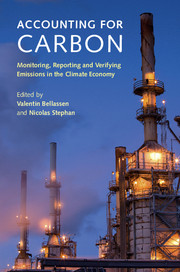Book contents
- Frontmatter
- Contents
- List of figures and map
- List of tables
- List of boxes
- Notes on contributors
- Acknowledgements
- 1 Introduction: key notions and trade-offs involved in MRVing emissions
- Part I MRV of territorial/jurisdictional emissions
- Part II MRV of industrial sites and entities
- Part III MRV at offset project scale
- 11 Trendsetter for projects: the Clean Development Mechanism
- 12 Case study 1: monitoring requirements for projects reducing N2O emissions from fertilizer use across standards
- 13 Case study 2: monitoring requirements for reforestation and improved forest management projects across standards
- 14 Case study 3: monitoring requirements for fugitive emissions from fuels in the CDM
- 15 Synthesis
- Index
- References
14 - Case study 3: monitoring requirements for fugitive emissions from fuels in the CDM
from Part III - MRV at offset project scale
Published online by Cambridge University Press: 05 March 2015
- Frontmatter
- Contents
- List of figures and map
- List of tables
- List of boxes
- Notes on contributors
- Acknowledgements
- 1 Introduction: key notions and trade-offs involved in MRVing emissions
- Part I MRV of territorial/jurisdictional emissions
- Part II MRV of industrial sites and entities
- Part III MRV at offset project scale
- 11 Trendsetter for projects: the Clean Development Mechanism
- 12 Case study 1: monitoring requirements for projects reducing N2O emissions from fertilizer use across standards
- 13 Case study 2: monitoring requirements for reforestation and improved forest management projects across standards
- 14 Case study 3: monitoring requirements for fugitive emissions from fuels in the CDM
- 15 Synthesis
- Index
- References
Summary
Fugitive emissions scale and scope
Fugitive emissions are uncontrolled releases from leaking equipment (assumed to be sealed), uncontrolled but routine venting or emissions to air from other uncontrolled sources. Although they are unmonitored releases they are not necessarily unintentional, for example compressor stations may have planned but unmonitored releases. In this chapter the term fugitive emissions follows the definition in the Revised 1996 IPCC Guidelines, “an intentional or unintentional release of gases from anthropogenic activities excluding the combustion of fuels” (IPCC, 1997). Fugitive emissions are significant sources from the mineral oil refining and natural gas industry due to the large number of components which are potential sources at each facility. Emissions tend to occur from production, distribution and storage processes. There can be numerous leak sources throughout a single plant and this diffuse nature makes them difficult to detect and quantify. This chapter will focus on component leaks within the scope of above-ground equipment.
For CDM project activities there is an interest in mitigating or reducing greenhouse gas emissions and hence this case study will focus on the detection and quantification of fugitive methane emissions. However, it should be noted that many of the methodologies are based on techniques developed in the oil and gas industry to detect hydrocarbon emissions. Fugitives and combustion account for 19 percent of reported methane emissions in Europe (Global Methane Initiative, 2013). Methane is the primary constituent of natural gas, with the potential to be emitted to the atmosphere during production, processing, storage, transmission and distribution (UNEP/WMO,2011).
Offset projects based on the capture of fugitive methane are attractive to project developers: there are currently ten CDM methodologies (see Table 14.3 in the appendix) relevant to fugitive emissions from fuels (mining, oil wells, gas flaring in power plants, equipment leaks and low carbon electricity). As of December 31st, 2013, 215 projects using these methodologies had registered under the scope of this sector (2.6 percent of all registered CDM projects) (UNFCCC, 2013a).
- Type
- Chapter
- Information
- Accounting for CarbonMonitoring, Reporting and Verifying Emissions in the Climate Economy, pp. 467 - 509Publisher: Cambridge University PressPrint publication year: 2015



